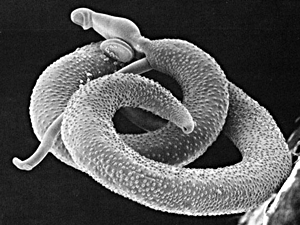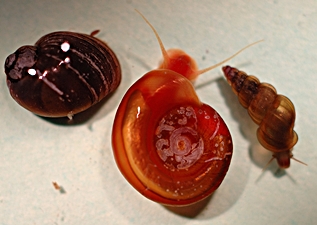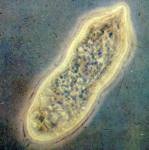
A pair of Schistosoma mansoni (SEM Picture).
Picture: Stephen J. Davies (Source).
 A pair of Schistosoma mansoni (SEM Picture). Picture: Stephen J. Davies (Source). |
The cause of Bilharziosis is a round worm (Trematoda) by the scientific name of Schistosoma – the blood fluke. The most important species are Schistosoma mansoni, Schistosoma haematobium and Schistosoma japonicum.
In fact the blood fluke usually is two animals, a male and a female living as a pair in lifelong copula. The female, a bit longer than the male, in whose ventral groove (gynecophoral canal) it remains. Both, male and female, measure about 1 to 2 cm (0.5 to 1 inch) in length.
A bilharziosis infection may occur in shallow fresh waters in the tropics, where an animal lives, that is indispensable as the fluke's alternate host. This intermediate host always is a fresh water snail.
 Bulinus truncatus, Biomphalaria glabrata and Oncomelania hupen- sis in a lab. Source: Lewis, Liang, Raghavan, Knight (2008). |
For example, the intermediate host to Schistosoma mansoni is Biomphalaria glabrata, a member of the ram's horn snail family (Planorbidae, Basommatophora). So does Bulinus truncatus. Oncomelania hupensis finally belongs to the Pomatiopsidae (Caenogastropoda) family (not to be confounded with the terrestrial Pomatiidae family).
![]() Systematics of Gastropoda: Clade
Caenogastropoda: Pomatiopsidae.
Systematics of Gastropoda: Clade
Caenogastropoda: Pomatiopsidae.
|
Species |
Schistosoma mansoni | Schistosoma haematobium | Schistosoma japonicum |
| Intermediate host | Biomphalaria glabrata | Bulinus truncatus | Oncomelania hupensis |
| Distribution | Africa, Saudi-Arabia, South America, Caribbean | Africa | Japan, China, Philippines |
The fluke's eggs are spread in the water together with its terminal host's droppings. The final host may be a human or another species of mammal. In the water, the so called miracidia, the basic larval generation, hatch from the fluke's eggs. The miracidia only live for 48 hours, during which time they have to find an alternate host. Unless they find a suitable host organism, they die. Inside the host organism, which has to be of a suitable snail species, the miracidia perform a metamorphosis, during which they develop into cercariae.
 |
 |
The cercariae leave the host organism by passing the body wall and are able to survive another two days swimming freely in the water. In this time they infect mammals standing in the water by passing through their body wall into the legs. Through the blood vessels the cercariae wander into the host's liver, which is where they develop into adult flukes, mate and lay eggs. Those are transported away in the blood stream and distributed over intestine and ureter.
Humans are harmed by skin rashes caused by the cercariae entering the skin during infection. They also hamper the organism causing heavy, possibly fatal, fevers. The eggs lastly may block blood vessels. The eggs leaving the body may harm intestine, ureter and bladder walls even causing cancer symptoms. The immune response against the Schistosomiasis parasite is especially difficult, because the flukes mask their exterior with cells from the hosts body, in order not to be recognized by immune system cells.
Measures are taken to minimize the risk of bilharziosis infection in affected regions. Besides directly killing suitable fresh water snails by poisoning them, also their habitats are destroyed by removing the waterside vegetation they live in.
Especially dangerous areas are shallow warm standing waters, such as rice fields and irrigation projects.